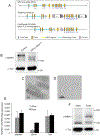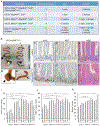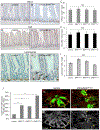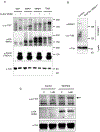The Misshapen subfamily of Ste20 kinases regulate proliferation in the aging mammalian intestinal epithelium
- PMID: 31042012
- PMCID: PMC6711781
- DOI: 10.1002/jcp.28756
The Misshapen subfamily of Ste20 kinases regulate proliferation in the aging mammalian intestinal epithelium
Abstract
The intestinal epithelium has a high rate of cell turn over and is an excellent system to study stem cell-mediated tissue homeostasis. The Misshapen subfamily of the Ste20 kinases in mammals consists of misshapen like kinase 1 (MINK1), mitogen-activated protein kinase kinase kinase kinase 4 (MAP4K4), and TRAF2 and NCK interacting kinase (TNIK). Recent reports suggest that this subfamily has a novel function equal to the Hippo/MST subfamily as upstream kinases for Warts/Large tumor suppressor kinase (LATS) to suppress tissue growth. To study the in vivo functions of Mink1, Map4k4, and Tnik, we generated a compound knockout of these three genes in the mouse intestinal epithelium. The intestinal epithelia of the mutant animals were phenotypically normal up to approximately 12 months. The older animals then exhibited mildly increased proliferation throughout the lower GI tract. We also observed that the normally spatially organized Paneth cells in the crypt base became dispersed. The expression of one of the YAP pathway target genes Sox9 was increased while other target genes including CTGF did not show a significant change. Therefore, the Misshapen and Hippo subfamilies may have highly redundant functions to regulate growth in the intestinal epithelium, as illustrated in recent tissue culture models.
Keywords: MAP4K4; MINK1; Ste20 kinases; TNIK; hippo; intestine; misshapen.
© 2019 Wiley Periodicals, Inc.
Figures





Similar articles
-
The Ste20 Family Kinases MAP4K4, MINK1, and TNIK Converge to Regulate Stress-Induced JNK Signaling in Neurons.J Neurosci. 2017 Nov 15;37(46):11074-11084. doi: 10.1523/JNEUROSCI.0905-17.2017. Epub 2017 Oct 9. J Neurosci. 2017. PMID: 28993483 Free PMC article.
-
The conserved misshapen-warts-Yorkie pathway acts in enteroblasts to regulate intestinal stem cells in Drosophila.Dev Cell. 2014 Nov 10;31(3):291-304. doi: 10.1016/j.devcel.2014.09.012. Epub 2014 Nov 10. Dev Cell. 2014. PMID: 25453828 Free PMC article.
-
Mst1 and Mst2 protein kinases restrain intestinal stem cell proliferation and colonic tumorigenesis by inhibition of Yes-associated protein (Yap) overabundance.Proc Natl Acad Sci U S A. 2011 Dec 6;108(49):E1312-20. doi: 10.1073/pnas.1110428108. Epub 2011 Oct 31. Proc Natl Acad Sci U S A. 2011. PMID: 22042863 Free PMC article.
-
Clinical Potential of Misshapen/NIKs-Related Kinase (MINK) 1-A Many-Sided Element of Cell Physiology and Pathology.Curr Issues Mol Biol. 2024 Dec 5;46(12):13811-13845. doi: 10.3390/cimb46120826. Curr Issues Mol Biol. 2024. PMID: 39727954 Free PMC article. Review.
-
The Hippo Tumor Suppressor Pathway (YAP/TAZ/TEAD/MST/LATS) and EGFR-RAS-RAF-MEK in cancer metastasis.Genes Dis. 2019 Dec 5;8(1):48-60. doi: 10.1016/j.gendis.2019.11.003. eCollection 2021 Jan. Genes Dis. 2019. PMID: 33569513 Free PMC article. Review.
Cited by
-
A small-molecule TNIK inhibitor targets fibrosis in preclinical and clinical models.Nat Biotechnol. 2025 Jan;43(1):63-75. doi: 10.1038/s41587-024-02143-0. Epub 2024 Mar 8. Nat Biotechnol. 2025. PMID: 38459338 Free PMC article. Clinical Trial.
-
Interplay of RAP2 GTPase and the cytoskeleton in Hippo pathway regulation.J Biol Chem. 2024 May;300(5):107257. doi: 10.1016/j.jbc.2024.107257. Epub 2024 Apr 2. J Biol Chem. 2024. PMID: 38574891 Free PMC article.
-
Identification and Biological Evaluation of a Novel CLK4 Inhibitor Targeting Alternative Splicing in Pancreatic Cancer Using Structure-Based Virtual Screening.Adv Sci (Weinh). 2025 May;12(19):e2416323. doi: 10.1002/advs.202416323. Epub 2025 Mar 24. Adv Sci (Weinh). 2025. PMID: 40126184 Free PMC article.
-
Misshapen Disruption Cooperates with RasV12 to Drive Tumorigenesis.Cells. 2021 Apr 14;10(4):894. doi: 10.3390/cells10040894. Cells. 2021. PMID: 33919765 Free PMC article.
-
Comprehensive analysis of senescence-related genes and immune infiltration in intervertebral disc degeneration: a meta-data approach utilizing bulk and single-cell RNA sequencing data.Front Mol Biosci. 2023 Dec 22;10:1296782. doi: 10.3389/fmolb.2023.1296782. eCollection 2023. Front Mol Biosci. 2023. PMID: 38187091 Free PMC article.
References
-
- Anazi S, Shamseldin HE, AlNaqeb D, Abouelhoda M, Monies D, Salih MA, Al-Rubeaan K, and Alkuraya FS. 2016. A null mutation in TNIK defines a novel locus for intellectual disability. Hum Genet. 135:773–778. - PubMed
-
- Beumer J, and Clevers H. 2016. Regulation and plasticity of intestinal stem cells during homeostasis and regeneration. Development. 143:3639–3649. - PubMed
Publication types
MeSH terms
Grants and funding
LinkOut - more resources
Full Text Sources
Medical
Research Materials
Miscellaneous

